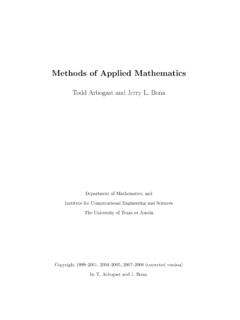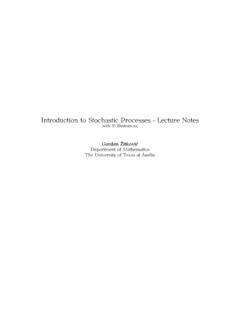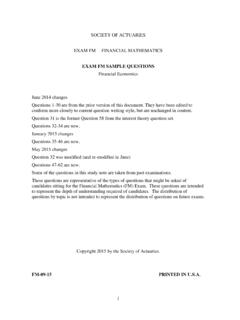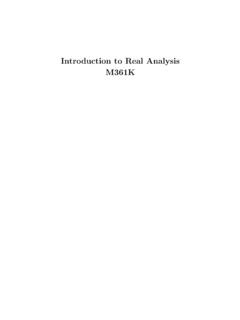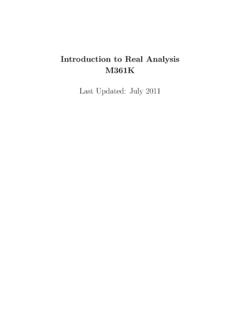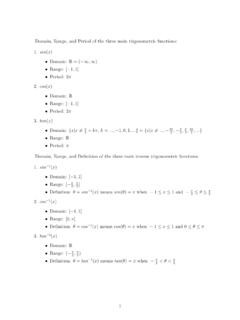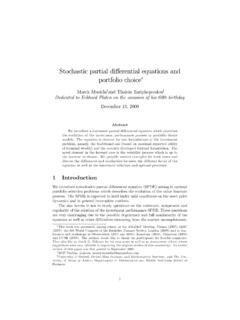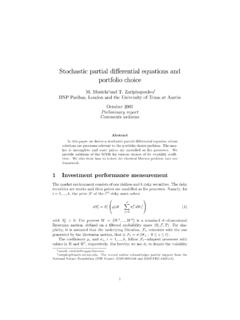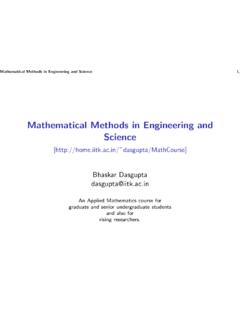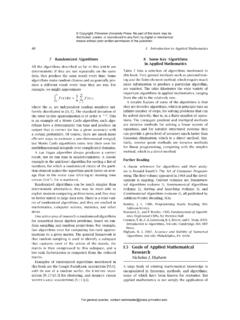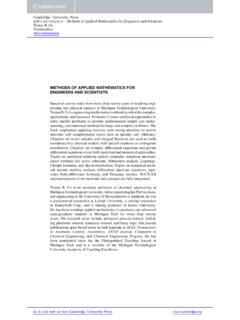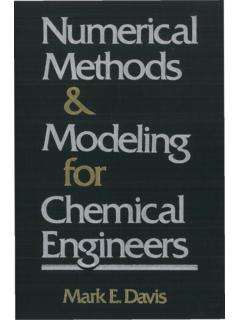Transcription of M383C: Methods of Applied Mathematics - web.ma.utexas.edu
1 M383C: Methods of Applied MathematicsArun DebrayDecember 12, 2015 Source: notes were taken in UT Austin sM383 Cclass in Fall 2015, taught by Todd Arbogast. I live-TEXed them usingvim, and assuch there may be typos. Please send questions, comments, complaints, and corrections 1. Normed Linear Spaces and Banach General Remarks: 8/26 Banach Spaces: 8/28 Bounded Linear Operators: 8/31 `p-norms: 9/2 `pandLp-spaces: 9/4 ( )is Banach: 9/9 The Hahn-Banach Theorem: 9/11 The Hahn-Banach Theorem, II: 9/14 Separability: 9/16 The Minkowski Functional and the Baire Category Theorem: 9/18 The Open Mapping Theorem: 9/21 The Uniform Boundedness Principle: 9/23 Weak and Weak- Convergence: 9/25 The Banach-Alaoglu Theorem: 9/28 The Generalized Heine-Borel Theorems: 9/30 The Dual to an Operator: 10/2/1535 Chapter 2.
2 Inner Product Spaces and Hilbert Orthogonality: 10/5 Projections: 10/7 Orthonormal Bases: 10/9 Midterm Breakdown: 10/12 Classification of Hilbert Spaces: 10/14 Fourier Series and Weak Convergence in Hilbert Spaces: 10/16/1550 Chapter 3. Spectral Basic Spectral Theory in Banach Spaces: 10/19 Compact Operators: 10/21 Spectra of Compact Operators: 10/23 The Spectral Theorem for Compact Operators: 10/26 The Spectral Theorem for Self-Adjoint Operators: 10/28 The Spectral Theorem for Self-Adjoint Operators, II: 10/30 Positive Operators: 11/2 Compact, Self-Adjoint Operators and the Ascoli-Arzel Theorem: 11/4 Sturm-Liouville Theory: 11/6 Solving Sturm-Liouville Problems With Green s Functions: 11/9 Applying Spectral Theorems to Sturm-Liouville Problems.
3 11/11/1573 Chapter 4. The Space of Test Functions: 11/16 Distributions: 11/18 Examples of and Operations on Distributions: 11/20 Differentiation of Distributions: 11/23 Midterm 2 Review: 11/25 Convolution of Distributions: 11/30 Applications of Distributions to Linear Differential Equations: 12/2 Linear Differential Operators with Constant Coefficients: 12/4/1593 CHAPTER 1 Normed Linear Spaces and Banach SpacesLecture 1: 8/26/15 General the course name is Methods of Applied Mathematics , this is a misnomer; the course is really aboutfunctional course will use the Canvas website ( ), and office hours will be afterclass (modulo lunch), Mondays and Wednesdays from 12:30 to 1:50.
4 Under UT Direct, there s also a CLIPS page,but that s less central to the textbook is a set of course notes; it hasn t changed much since 2013, so if you have that version, you ll befine. They ll be ready at the copy center by Friday or will be due every week, assigned one Friday, and due the next. The first assignment will be due ina little over a week. We re encouraged to work in groups, but must write up our own individual proofs. Midtermswill be weeks 7 and 12, probably, and will be topical; the final, at the end of the semester, will be this course, we ll cover chapters 2 5 of the lecture notes.
5 Some elementary topology and Lesbegueintegration (the first chapter) will be , for some math. The professor is an Applied mathematician, doing numerical analysis, and morespecifically, approximation of differential equations. Functional analysis is useful for that, but also plenty of otherfields, even including abstract algebra! Nonetheless, the course will be presented from an Applied background is that we re trying to solve a problem of the formT(u)=f. Here,Tis a model or differentialequation; it s some kind of the data that we re given, and we want to find the solutionu.
6 We use theframework of functional analysis to understand the nature of the functionsuandf: their properties and whatclasses of functions they live in. We also want to know the nature of the operatorT. In particular, we ll focus oncases whereTis linear, since anything nonlinear can usually be locally approximated with a linear one. Thus, weshould start with the linear set of all functions is a vector space, of course, so we re led to study vector spaces. At the undergraduatelevel, one studies finite-dimensional spaces, but here we ll use infinite-dimensional ones.
7 Vector spaces also give usthe required linearity. But since we also have questions of convergence, we ll introduce topology, so this coursecombines algebra and this class,Fwill denote a field, eitherRorC(a lot of the time, the stuff we re doing won t depend onwhich). a vector space overF. Then,Xis anormed linear space(henceforth NLS) if it has anorm, afunction :X R+=[0, )such that for everyx,y Xand F, x =| | x , x =0 iffx=0, and x+y x + y .The last stipulation is called thetriangle conditions on the norm mean it s a measure of size: stretching a vector stretches the norm, the onlything with size 0 is the origin, and the triangle inequality corresponds to the familiar geometric one.]
8 It turns outthese are the only properties we need to measure General Remarks: 8/26/154 Example (1)d-dimensionalEuclidean spaceFdcomes with a familiar norm: ifx=(x1, .. ,xn)forxj F, then x = d j=1|xj| , this is simply denoted|x|. Thus, whenever we talk aboutFd, we really mean(Fd, ), thenormed linear space.(2)Ifa<b, wherea,b [ , ], letC([a,b])denote the space of continuous functionsf:[a,b] Fsuch thatsupx [a,b]|f(x)|is is indeed a vector space; then, it turns to a normed linear spacewith the norm f =supx [a,b]|f(x)|.Notice that the norm must be finite, which is satisfied here.
9 The first two properties are clearly satisfied,and because the absolute value is a norm onR, then the triangle equality is also satisfied.(3) We can pairC([a,b])with a different norm L1, defined by f L1= ba|f(x)| integral certainly exists, sincefis continuous, but it might be infinite; thus, we assume thataandbare finite, so[a,b]is compact, and ba|f(x)|dx (b a)supx [a,b]|f(x)|,so we re bounded. It s also not that hard to show that L1is a norm, as the integral is now have two norms onC([a,b]); are they the same? Though the underlying vector spaces are thesame, the measures of size are different, so as normed linear spaces they are not the can find more examples sitting inside other (X, )be an NLS and V X be a linear subspace.
10 Then,(V, )is an s easy to check that the three requirements are still can measure size, so since we re in a vector space, we can measure distance. In general, we have a , if(X, )is an NLS, defined:X X R+byd(x,y)= x y . Why is this a metric? It has tosatisfy the following three properties for allx,y,z X.(1)d(x,y)=0 iffx=y.(2)d(x,y)=d(y,x).(3)d(x,y)+d(y,z) d(x,z).It s easy to check that thedinduced from the norm is indeed a metric; each metric property follows from one ofthe norm now that we can measure distance, we have a topology; specifically a metric topology, the simplest of alltopologies.
